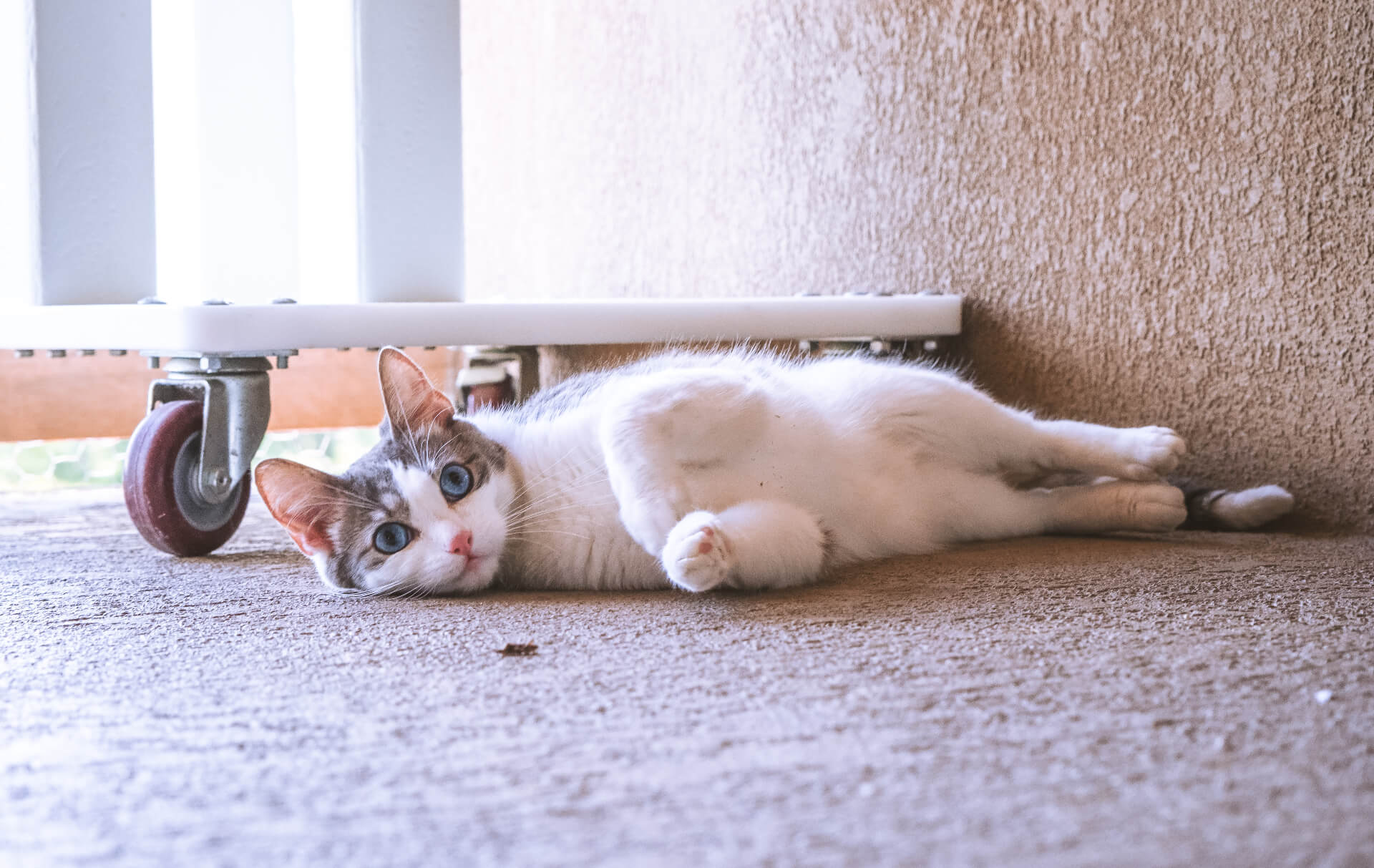
Introducing Your Cat To Your Dog
First impressions are very important for successful cat to dog introductions. All cats and dogs are individuals and may get along with one dog or cat and not another. It is important to set your cat and dog up to succeed by managing the environment and the introduction process.
Preparing Ahead
- Give her a place of her own – Whether it is a cat or dog that is new to your home it is still important to provide your cat with an area of her own for the introduction process. If you are bringing home a new cat, isolate her in her own room with all her necessities for 1-2 weeks. The amount of time your new cat will need to adjust to her new surroundings, people, and routine before she will be ready to meet other pets in the home will depend on her personality and prior socialization. During the isolation period, place bedding from your resident pets into her room so that she gains familiarity with their scent. For a new dog, provide her with a crate or puppy-proofed space that will be her “room” so that you can separate her from the cat when unsupervised.
- Train – Introductions will be easier and faster if your dog has prior training and is responsive to your directions. Teaching your dog “leave it” and “come” are especially helpful. If your dog is the newcomer to your home you may need to manage her movements throughout the house with the use of baby gates and/or crates or consider having separate cat and dog areas until you can work on training your new dog.
The Introductions
- First impressions – When your cat is comfortable in the room you’ve chosen for her, put a baby gate in the doorway to proceed with the introduction. Fill your pockets with tasty treats that both your cat and dog enjoy (such as bits of chicken and cheese). Walk your leashed dog past the room slowly a few times a day for a couple of days. Praise and treat your dog for calm behavior and toss the cat a treat as well. If your dog overreacts to the cat, redirect her attention to you using the treats and ask her to perform tasks such as “sit” and “down” to keep her focus. Meanwhile, your cat is free to approach the gate or move away from it as she wants to. Toss her a tasty snack every time she approaches the gate to help her associate the dog with wonderful treats.
- Let your cat set the pace –Taking things slowly will help avoid a poor first impression. Keep in mind that cats can take months to form relationships with other animals. If your cat’s response to these initial walk-bys is to run and hide under the bed the introduction may take longer.
- Continuing the introduction – Once your cat doesn’t seem afraid of your dog as you pass by her room, or if she tries to jump over the gate, you can introduce them in your living room or other large room. Place your cat on top of the couch or on a tall table so she is higher than your dog. Make sure your cat can get away from your dog during the introduction. She should have the freedom and room to retreat, run and hide, or jump up on something out of reach. Keep your dog with you on-leash during these introductions and for the first couple of weeks. Allow the leash to be loose, but hold onto it in case your dog decides to try to chase your cat. Use your recall and “leave it” exercises if your dog starts nosing or following your cat and she seems afraid. When you ask your dog to come to you or leave your cat alone, be sure to give her a very special treat. Continue to reward your cat as well for any interest in your dog or other confident behavior exhibited around your dog.
- Safety first – When you’re not present or can’t actively supervise them, keep your cat and dog confined in separate areas of the house.
Why Things Go Wrong
- Prey drive – Dogs will instinctually chase a fast moving object. This is why it is so important to keep your dog on leash during the introduction process.
- Resource Guarding – Both cats and dogs may guard resources such as sleeping spots, food, toys or you.
- Interspecies communication challenges – Dogs and cats speak different languages. For cats, it is socially acceptable to greet nose-to-nose, for dogs this is an assertive behavior and a more appropriate greeting is nose-to-rear. Play behaviors are also very different in cats and dogs. Both species can learn to interpret the other’s language, however early socialization and positive experiences are key to this occurring.
- Rushed introductions – Forced introductions that happen too quickly often create negative interactions. Remember, the first impression is very important to a successful relationship between your cat and dog.
- Household changes – Anything that upsets the normal routine can cause stress and result in strained interactions between pets. Big events such as moving, a new baby, or a new pet can cause stress. Also, less obvious events like rearranging the living room furniture can be a stressor that leads to strained interactions between household pets.
- Improper environmental setup – It is important to arrange your house in a way that meets the needs of all your pets. Remember that cats live in the vertical environment as much as the horizontal. Use perches, cat trees, and the arrangement of furniture to create “kitty highways” off of the ground. Each animal should always have their own space where they know they can go and not be bothered by the other pets. Furniture should be arranged to allow cats to go under or behind if they want to hide.
- Mental and/or physical needs not met –Lack of mental stimulation and exercise increase your pet’s stress level. A bored cat or dog is more likely to cause conflict.
What Not To Do
- Let them work it out – This strategy does not work for major issues such as chasing or severe aggression. It is also dangerous and may lead to physical injury. The more negative interactions that occur the harder it will be for your cat and dog to develop a good relationship.
- Force interactions – Never attempt to force any interactions by holding your cat, putting her into a crate or restricting her movement in any way. If your cat wants to escape, let her go but start working on desensitization training to help her gain confidence around your dog. If your dog is fearful of the cat at first, use desensitization training for her.
- Punishment – While punishment may initially decrease the behavior, it creates a negative association with the new animal and increases your pets’ stress. Ultimately, you want your animals to coexist and even like each other. Punishment will not help and will harm your relationships with your pets.
